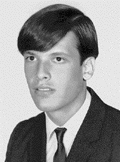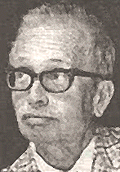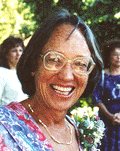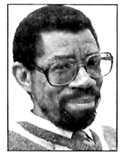|
Women
and Minorities in Meteorology since 1950
Due
to the Civil Rights Movement and increased immigration from Asia, Africa,
and the Americas, black and Hispanic atmospheric scientists became more
common in the United States after World War II. Renewed efforts in the
cause of Women's Rights freed more women to enjoy both family and career
for the first time, and such women increasingly turned to careers in
science. Here are some of the more prominent pioneering women and minority
scientists of the time.
Margaret
E. Courain (1927-1994)
Margaret Courain had a successful career in the pharmaceutical
industry before moving to the National Oceanic and Atmospheric Administration
in 1981. She received a B. S. in Chemistry from Douglass College of
Rutgers University in 1948, and M.S. in Library Science from Columbia
University in 1955. She worked at Merck Research Lab-oratory in Rahway,
NJ, 1949-1981, where she developed information systems and management
training. At NOAA, she consolidated four major national databases, and
was named Deputy Assistant Administrator of the National Environmental
Satellite, Data, and Information Service. She returned to Rutgers, at
its School of Communication, Information and Library Science, writing
her Ph.D. dissertation in 1991on "Technology Reconciliation in the Remote-Sensing
Era of the United States Civilian Weather Forecasting: 1957-1987." She
was a member of the World Meteorological Organization Commission on
Climatology and the Board of Advisors of the Rutgers Women in Science
and Mathematics, a Fellow of the American Institute of Chemists, vice-president
of the Drug Information Association, and a Distinguished Alumna of Douglass
College. She co-chaired a number of advisory boards within the United
States Government. She died of cancer on 13 January 1994 in South Orange,
NJ.
Christine
Ann Sherman (1940-1979)
Christine Ann Sherman spent most of her career working
on atmospheric modeling at the Lawrence Livermore Laboratory. She received
a B.S. at Stanford University in 1962 and M.S. from the University of
California at Davis in 1966. She worked at LLL 1962-1965 as a programmer
for general circulation model development. After receiving her B. S.,
she took a short hiatus from LLL to work as a physicist at Physics International,
Inc., but returned to LLL in 1967 where she worked as a physicist in
the theoretical Physics Division and in the Atmospheric and Geophysical
Sciences Division until her death. She attained a Ph.S. from the University
of California at Davis in 1978.
 |
|
Roberto Ortiz
(courtesy I. V. Ortiz)
|
Roberto
Ortiz (1950-1994)
Roberto Ortiz worked as both a forecaster and research
meteorologist. He received his B.S. in Meteorology from Florida State
University in 1972. He held numerous positions with the National Weather
Service, including work as an airway observer at the Miami National
Weather Service Office, and a forecaster at the San Juan NWS Office.
After a short stint at the U. S. Army Proving Grounds in Dugway, UT,
he returned to NOAA, doing research at the Environmental Research Laboratories
in Boulder (1985-1992), and then at the National Severe Storms Laboratory
in Norman, OK, until his death on 29 June 1994.
Mae
Lethbridge (1909-1996)
Mae Lethbridge was one of the first woman Ph.D.s
in meteorology. She graduated from Pennsylvania State College in 1943
with a B.S. She attended Radcliffe College, studying astronomy, climatology,
and the ionosphere, graduating with a M.S. in 1947. She then returned
to Pennsylvania State College, earning a Ph.S., emphasizing ionospheric
research and lunar tides in the E layer. She remained at Penn State
the remainder of her career as a researcher, working on the relationship
between the sun and weather for the Air Force and on lunar and solar
factors in tornadoes and thunderstorms. She left Penn State in 1970
to pursue independent research, but remained involved at the University.
She died 12 October 1996 in State College, PA.
Jaime
Amorocho (1920-1983)
Jaime Amorocho was a prominent hydrologist and civil
engineer during his long career in academia and the private sector.
He received a B.S. from the Universidad Nacional de Colombia in 1943,
and emigrated to the U.S. later that year. He received his M.S. in Civil
Engineering at the Pennsylvania State University in 1946, working as
a private engineer for a number of companies in both Colombia and the
U.S. He returned to the U.S. to achieve his Ph.S. in Hydrology from
the University of California-Davis in 1961, and soon thereafter became
assistant professor of hydrology and hydraulics there. He later became
professor of water science and engineering at the same institution.
He earned the Robert E. Horton Award from the American
Geophysical Union in 1974, given by the AGU Hydrology Section for contributions
over a career. He was a member of the National Academy of Sciences in
Colombia. After his death in late November 1983, a Jaime Amorocho Memorial
Scholarship fund was established for deserving civil engineering students
in the field of water resources. As a further testament to his abilities,
the University of California at Davis now houses the Jaime Amorocho
Hydraulics Laboratory and Centrifuge Site.
Margaret
Downs (1906-1973)
Margaret Downs was a geographer and instructor. She
graduated with a B.A. in History from Randolph-Macon College in Lynchburg,
VA in 1929, and achieved an M.A. in Geography from Columbia University
in 1933. She taught Geography at the Hunter College of the City of New
York (1941-1948), and later worked as a research analyst at the Army
Map Service (1955-1961). During this time, she also worked on her Ph.D.
in Geography from the University of Maryland (1957). Her career culminated
in her assignment of professor of geology, geography, and climatology
at Southern Connecticut State College in New Have. She died 31 December
1973.
 |
|
Jose Fernandez-Partagas
|
Jose
Fernandez-Partagas (1935-1997)
Jose Partagas-Fernandez was a Cuban born meteorologist
and meteorological historian. He was born and educated in Havana where
he achieved his bachelor degree in science and letters at the Edison
Institute and his Ph.D. in Physics and Mathematics at the University
of Havana. He worked at the Cuban National Weather Service National
Observatory in Havana until emigrating to the U.S. in 1961. He returned
to school, graduating Florida State University with an M.S.. He worked
for a time in the Civil Aviation Division of the Bahamian Weather Service,
and returned to the U.S. in 1966 to become a research associate at the
University of Miami Rosensteil school of Marine and Atmospheric Sciences
Division of Meteorology and Physical Oceanography.
Later years of his life were spent discovering and
reconstructing the tracks of North Atlantic tropical cyclones since
1850, combining existing sources with information from microfilmed shipping
reports and newspaper accounts. This was difficult and meticulous work
that he accomplished alone with his own resources. At the time of his
death, he had completed the years 1850-1910. His work will be the basis
of all Atlantic hurricane climatology work in the future.
Dedicating all his resources to his work, he was
nearly homeless, spending 17 hours each day at the University of Miami
Richter Library, where he was found dead 25 August 1997. He had no next
of kin, so his remains were claimed by scientists at the National Hurricane
Center, and were disbursed during a short ceremony in the eye of Hurricane
Danielle (1998) by NOAA's Hurricane Research Division and Aircraft Operations
Center.
 |
|
Susan Swartz Bunker
(courtesy Brian Bunker)
|
Susan
Swartz Bunker (1933-1992)
Susan Swartz Bunker spent most of her career in the atmospheric sciences
group at Los Alamos National Laboratory. She was born 7 October 1933
in Detroit, MI, and received a B.A. in Biology at Antioch College in
1950. She also earned a certificate in occupational therapy from Wayne
State University in Detroit in 1958. She worked at LANL as a senior
data analyst from 1960-1964 and 1971 until her death. During that time,
she helped to form a mesoscale modeling group, developed and improved
meteorological and pollution transport codes, nested four dimensional
data assimilation techniques and random puff transport codes. She took
part in numerous field experiments such as the Atmospheric Studies over
Complex Terrain (ASCOT) and the Cross-Appalachian tracer Experiment
(CAPTEX). She died 8 April 1992 in Albuquerque, NM.
 |
|
Thomas A. Carney
(courtesy Florida State University Department of Meteorology)
|
Thomas
A. Carney (1945-1989)
Thomas Carney was a pioneer African-American meteorologist,
teacher, and mentor to minority scientists. He received a B.S. in Physics
from Tennessee State University in 1967, and was a Weather Officer in
the Air Force 1967-1971, during which time he earned an Air Force Commendation
Medal. He left the Armed Forces and returned to school and then a Ph.D.
from the same institution in 1984. He held various positions at the
Tennessee Air Pollution Control Agency, Brookhaven Nation-al Laboratory,
and the National Aeronautical and Space Agency Langley Research Center
in Hampton, VA. In all these positions, he performed research into air
pollution. He became Associate Professor of Meteorology at Florida State
University in 1984 where he became director of ozone observations, won
a McKnight Junior Faculty Development Fellowship, and started a summer
institute for minority students using funds from a National Science
Foundation grant. It was his goal from childhood to be an educator and
a social activist, both at FSU and in the community. He died 13 October
1989, of complications due to AIDS. He is remembered with a minority
scholarship in his name.
Mary
Lavina Waggoner (1920-1968)
Mary Lavina Waggoner served in the U.S. Weather Bureau
for 25 years. She achieved a B.S. in Education from Bowling Green University,
and later took courses in meteorology and mathematics at George Washington
University and at the Department of Agriculture Graduate School. She
served as a meteorological aid in the Toledo, OH; Anchorage, AK; Nome,
AK; and Washington, DC, Weather Bureau Offices, and then as a meteorologist
at the Weather Bureau's Weather Analysis and Prediction Division until
her death in 1968.
Edna
Lois Scofield Stone (1906-1986)
Though married to Robert G. Stone, Editor of the
Bulletin of the American Meteorological Society (1934-1955), Edna Scofield
Stone was a noted scientist on her own. She achieved a B.A. in Geography
(1926) and an M.A. in Geography (1930) from the University of California
at Berkeley, specializing on the southeastern lowlands of Vancouver
Island. She achieved a Ph.D. in Geography from the University of Kiel
in Germany, on the Kurische Nehrung. She taught at Mills College and
Murfreesboro College, and then set up the training program in meteorology
for pilots at Pan American Airlines. She received a post-doctoral fellowship
from the American Association of University Women at the Massachusetts
Institute of Technology, where she worked on long-range weather forecasting
for the Weather Bureau (1940-1944). She died of cancer 15 February,
1986, in Quincy, PA.
|



